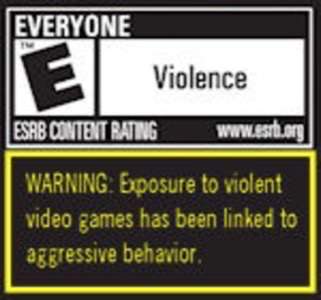Would it help you when reading the ratings for a video game as determined by the Entertainment Software Ratings Board, to read a warning that states violent video games have been linked to violent behavior? Would it help you if that warning appeared on all ratings for nearly all games, including those that have no violence whatsoever? Would it help if you knew what “linking” means in this context?

The latest version of a bill to amend the video game ratings system with mandatory violent behavior warnings, was introduced in the U.S. House of Representatives on Monday. It is (especially as bills go) very short – four paragraphs, with a bite-size format that suggests its readiness to be attached as a rider to other legislation, perhaps an appropriations bill more likely to pass without much debate. If the language finds its way into law, then a sensible means of informing buyers about the content of their software may be amended by mandate with a statement with which some scientists are not in agreement.
“Just as we warn smokers of the health consequences of tobacco,” states Rep. Frank Wolf (R – Va.), the bill’s co-sponsor, “we should warn parents and children about the growing scientific evidence demonstrating a relationship between violent video games and violent behavior.”
Whose Responsibility?
H.R. 4204, as presently conceived, would mandate the accompaniment of every ESRB rating badge for games not directed specifically to toddlers and very young children (“eC”) with the following: “WARNING: Exposure to violent video games has been linked to aggressive behavior.” The bill states the warning would need “to be placed on the packaging of any video game that is rated ‘E’ (Everyone), ‘Everyone 10+’ (Everyone 10 and older), ‘T’ (Teen), ‘M’ (Mature), or ‘A’ (Adult) [actually ‘Ao’ for “Adults only”] by the Entertainment Software Ratings Board.”

It’s the latest effort from Rep. Joe Baca (D – Calif.) to compel the video game industry to do something it’s been unwilling to do: place itself in the same league with cigarettes in the consumer’s mind. In a statement Monday, Baca showed he’s going into this effort with his sword already drawn: “The video game industry has a responsibility to parents, families, and to consumers, to inform them of the potentially damaging content that is often found in their products. They have repeatedly failed to live up to this responsibility.”
For its part, the Entertainment Software Association – which represents the interests of video game producers – denies the existence of such a responsibility, citing the nation’s highest source for rendering such a judgment. “Unfortunately, Rep. Baca’s facially unconstitutional bill… needlessly concerns parents with flawed research and junk science,” stated ESA senior VP Dan Hewitt yesterday. “Numerous medical experts, research authorities, and courts across the country, including the U.S. Supreme Court, exhaustively reviewed the research Rep. Baca uses to base his bill and found it lacking and unpersuasive. Independent scientific researchers found no causal connection between video games and real-life violence.”
ReadWriteWeb contacted spokespersons from the ESRB, who referred us to the ESA’s position.
The Supreme Court case Taylor cites is no trivial decision. Last June, the high court struck down a California ban on the sale or rental of some video games to minors. In the court’s decision paper, Justice Antonin Scalia wrote, “No doubt a State possesses legitimate power to protect children from harm… but that does not include a free-floating power to restrict the ideas to which children may be exposed.”
If something qualifies as media that’s protected under the First Amendment, Justice Scalia explained, then it cannot be restricted like a drug, or like some class of product that is not media. “California correctly acknowledges that video games qualify for First Amendment protection. The Free Speech Clause exists principally to protect discourse on public matters, but we have long recognized that it is difficult to distinguish politics from entertainment, and dangerous to try,” wrote Scalia. Citing from 1948 case law, he continued. “Everyone is familiar with instances of propaganda through fiction. What is one man’s amusement, teaches another’s doctrine.”
Although the Baca-Wolf bill would not impose a ban on the sale of any media, it would impose a regulation similar to those that are applicable to other classes of consumer items – thus the ESA’s argument that the bill is unconstitutional.
But also at issue is the whole issue of whether the language of the proposed warning is even correct – an issue which catches collateral cold water from Justice Scalia. Proponents of the California ban cited a 2001 Iowa State University study (PDF available here) that would appear to directly link violent gaming with violent behavior based on empirical data. Citing data from combined tests of a total of 3,033 individuals, the Iowa State team reached a positive conclusion, but in so doing drew a questionable comparison: “High video game violence was definitely associated with heightened aggression. Indeed, this effect of violent video games on aggression is as strong as the effect of condom use on risk of HIV infection.”
The Argument for Violence
Since that time, not only has the Iowa State team’s conclusions been called into question, but new studies emerged making the opposite argument: that violent video games can be directly linked to reduced stress and diminished real-world violent behavior.
“Our evidence contradicts both the social learning and catharsis hypotheses regarding violent video game effects on aggressive behavior,” reads a Texas A&M team’s conclusions dubbed “The Hitman Study” (PDF available here). “As with aggressive behavior, the evidence did not support that short-term randomized exposure to violent video games either increased or decreased hostile feelings or depression. By contrast, long-term exposure to violent video games was associated with reduced hostile feelings and depression following a stressful task. Subjects who were exposed to violent video games were not less aggressive, but they were less hostile and depressed.
These contradictory studies, coupled with material comparing outrage against violent video games to outrage against violence on television and the movies, led Justice Scalia to throw up his hands:

In the 1800’s, dime novels depicting crime and ‘penny dreadfuls’ (named for their price and content) were blamed in some quarters for juvenile delinquency… When motion pictures came along, they became the villains instead… For a time, our Court did permit broad censorship of movies because of their capacity to be ‘used for evil,’ movies restriction designed to protect children). Radio dramas were next, and then came comic books… Many in the late 1940’s and early 1950’s blamed comic books for fostering a ‘preoccupation with violence and horror’ among the young, leading to a rising juvenile crime rate… But efforts to convince Congress to restrict comic books failed. And, of course, after comic books came television and music lyrics.
California claims that video games present special problems because they are ‘interactive,’ in that the player participates in the violent action on screen and determines its outcome. The latter feature is nothing new: Since at least the publication of The Adventures of You: Sugarcane Island in 1969, young readers of choose-your-own adventure stories have been able to make decisions that determine the plot by following instructions about which page to turn to. As for the argument that video games enable participation in the violent action, that seems to us more a matter of degree than of kind. As Judge Posner has observed, all literature is interactive. “[T]he better it is, the more interactive. Literature when it is successful draws the reader into the story, makes him identify with the characters, invites him to judge them and quarrel with them, to experience their joys and sufferings as the reader’s own.”
Or in short, the more things change, the more nothing changes. The Baca-Wolf bill has been referred to the House Energy and Commerce Committee.
Stock image by Shutterstock










